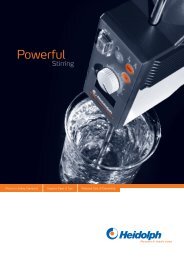download - Gaia Science
download - Gaia Science
download - Gaia Science
You also want an ePaper? Increase the reach of your titles
YUMPU automatically turns print PDFs into web optimized ePapers that Google loves.
attolight<br />
Attolight AG<br />
EPFL Innovation Square<br />
PSE D<br />
1015<br />
Description<br />
Lausanne<br />
Switzerland<br />
t<br />
The<br />
+41<br />
core<br />
21 626<br />
piece<br />
0100<br />
of Attolight's instrument is a<br />
custom designed scanning electron microscope<br />
www.attolight.com<br />
(SEM). SEM is a widely used scanning probe<br />
technology since it has the ability to image the<br />
surface features of a sample with very high<br />
spatial resolutions going below one nanometer<br />
(10 -9 m) today. An SEM consists of an electron<br />
source and electron optics that focuses the<br />
electron beam to a nanometer sized spot. The<br />
image (or map) is constructed by scanning the<br />
electron beam over the sample point by point<br />
(see Fig. 1). The impinging electron beam on<br />
the sample surface creates secondary electrons<br />
and photons that are emitted. At each scanned<br />
point on the sample, the intensity of the secondary<br />
electron (SE) signal is recorded and a<br />
pixel is shown on the screen with a grey scale<br />
level proportional to the SE signal intensity.<br />
incoming<br />
electron beam<br />
TECHNOLOGY BRIEF<br />
Attolight uses a proprietary technology to create<br />
ultrashort electron pulses instead of a continuous<br />
electron beam (see Fig. 2). The SEM<br />
and electron source have to be custom designed<br />
to reach high spatial resolutions and<br />
short pulses. Our new tool will deliver a few<br />
nanometers spatial resolution and pulses<br />
shorter than 10 picoseconds (1 picosecond =<br />
10 -12 s) at a repetition rate of typical 80 MHz<br />
(repetition rate can be changed easily). The<br />
photoelectric effect is used to create such short<br />
electron pulses: short UV laser pulses are sent<br />
on a thin metal film which creates short electron<br />
pulses. The design and manufacturing of<br />
the electron source is a core competence of<br />
Attolight. A lot of care has to be taken in designing<br />
the electron source and the electron<br />
optics in order to keep the pulses short and<br />
well focused and still intense enough to carry<br />
out measurements.<br />
electrons<br />
incoming<br />
electron beam<br />
Sample<br />
light<br />
Fig. 2 Attolight technology<br />
electrons<br />
Sample<br />
light<br />
Fig. 1 Principle of standard SEM<br />
Time resolved spectroscopy<br />
This is our “home” application in the R&D market.<br />
Initially, the tool was built for this application.<br />
We exploit a phenomena called cathodoluminescence<br />
(CL): some semiconductors emit<br />
light when they are bombarded with an electron<br />
beam containing electrons carrying a certain<br />
energy. This light is called CL and contains<br />
a lot of information on optical properties of the<br />
material under test. CL is often used to analyse<br />
semiconductor based nanostructures since the<br />
spatial resolution is very high. CL is a excitation<br />
spectroscopy technique with very high spatial<br />
resolution.<br />
Our idea was not just to look at a continuous<br />
CL signal but also at the lifetime of the signal<br />
in the picosecond regime. To achieve this we<br />
adapted an ultrafast light detector (STREAK<br />
camera) to our instrument. We call this tool<br />
pTRCL (picosecond time-resolved CL).<br />
© 2011 Attolight AG - All rights reserved.




